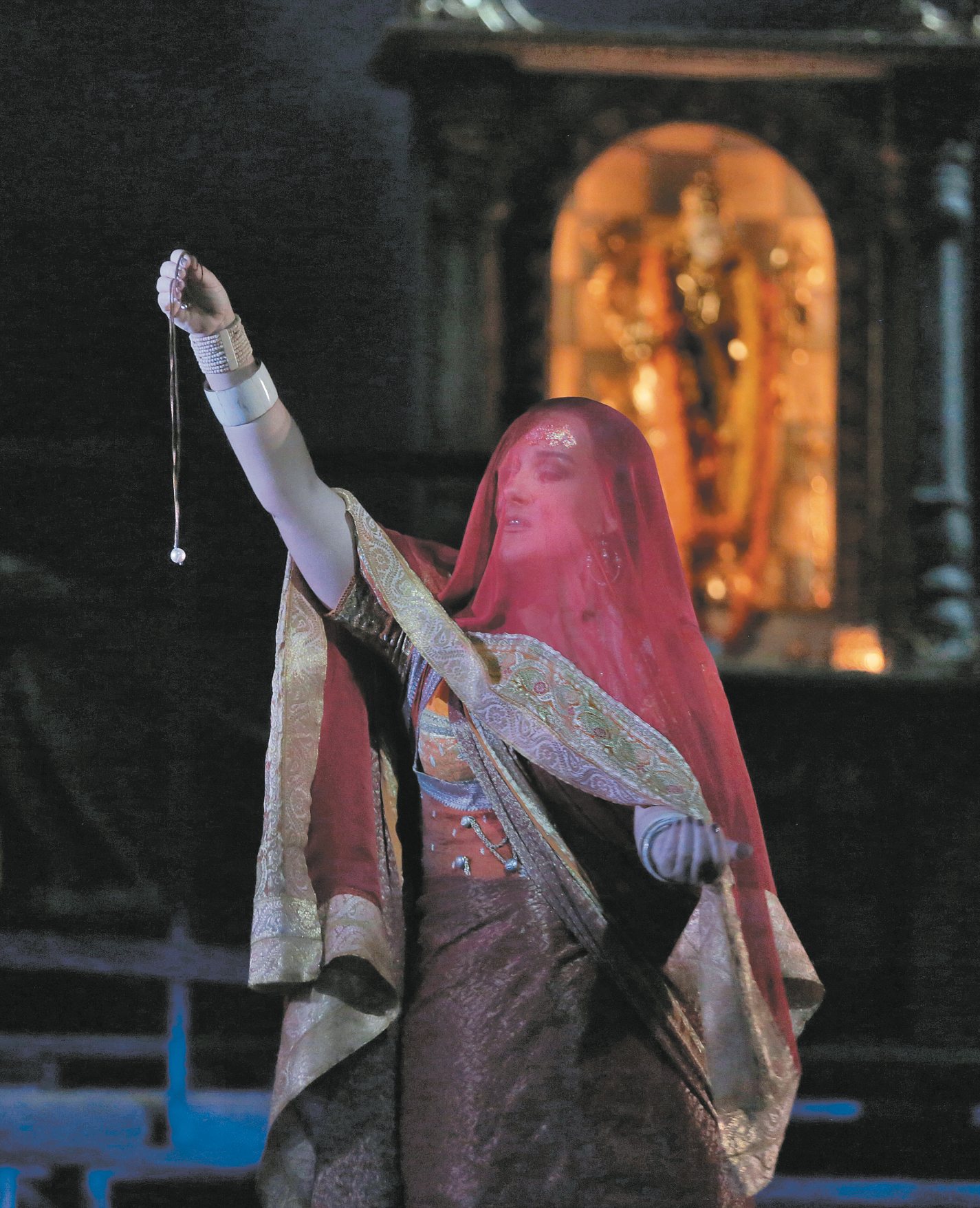“It’s a B-opera,” a voice purred sardonically in the row behind me at the Met, making a small puncture mark in what felt otherwise like general warm enthusiasm following a performance of Georges Bizet’s Les Pêcheurs de Perles. The speaker had a point. If a B-opera is something like a B-movie, then The Pearl Fishers has some of the same characteristics—brevity, spareness (four solo voices and a chorus carry the whole show), and rapid exposition—and is built around a libretto whose central elements might call to mind a Hollywood second feature along the lines of Bird of Paradise or Pearl of the South Pacific: an exotic isle (Ceylon), a prohibited desire, two friends torn apart by their love for the same woman, a devastating storm interpreted by superstitious islanders as a manifestation of divine wrath. In fact it was librettos like this that forged the path to second features like that.
Bizet, who was twenty-four at the time, was handed the libretto on short notice and can hardly be blamed for its thinness, pressured as he was to complete the score within a few months. In the event he turned its shortcomings into virtues. The blank spaces where characterization and dramatic development might have been became a generously open field for self-sufficient lyricism. The plot, such as it is, can be reduced to an overlapping set of mechanically laid-out conflicts: the priestess Leila (sworn to preserve her chastity to secure divine protection for the pearl fishers) is torn between her religious vow and her uncontrollable passion for the hunter Nadir, Nadir is torn between his passion for Leila and his friendship with the fisherman Zurga, and Zurga is torn between his friendship with Nadir and his jealous rage at being rejected by Leila.
After Leila and Nadir are caught in a forbidden embrace and condemned to death, it will be up to Zurga—in rueful atonement for having stirred up the pearl fishers to demand the execution of the lovers—to help the couple escape and offer himself to the vengeance of the mob. One might say that The Pearl Fishers is in some way “about” passion and friendship and, perhaps, the perils of superstitious belief, but the same could be said about the average Jon Hall vehicle. The opera’s true subject is its own music, which is another way of saying that it is indeed about passion.
The Ceylon on which The Pearl Fishers is set is as much an alternate fantasy world as any of the exotic locations in Rameau’s Les Indes Galantes (1735), updated with a very slight sprinkling of mid-nineteenth-century ethnographic pretensions. Essentially it’s an empty arena where elemental passions can surge unrestrainedly (until they slap up against the limits of an ominous and intransigent religion), a zone airily unencumbered by the tedium of European details and procedures and oppressive furniture. Penny Woolcock’s production, which originated at the English National Opera, fills out that zone by bringing the opera into something resembling the present. For the ruined pagoda and the scattering of bamboo huts and palm trees indicated in the libretto, she has substituted a populous waterfront shantytown whose pagoda is flanked on the far shore by a billboard advertising pearls. That it’s the modern world can be deduced from the blue jeans and wristwatches and refrigerators in evidence here and there, interspersed among more traditional accoutrements and structures.
The updating has oddly little effect on the import of the story; the central romantic triangle and the condemnation of the lovers by a punitive religious law are not significantly reshaped by being moved out of their timeless setting. The novel and unavoidable association provoked by this modernizing is the thought of the rising sea levels that in the era of global warming put such island communities in jeopardy. The association is underscored by the projection, later in the opera, of a photographic image of a giant wave, prompting memories of the tsunami of 2004. It is perhaps an attempt to reframe the devastating storm that befalls Zurga and his people—a disaster that for the Paris audience of 1863 was no more than the occasion for a frisson of romantic sublimity—by placing it under the sign of a genuine impending catastrophe. On the other hand, the water ballet with which Woolcock opens her production over the prelude with its rhythm of slowly pulsing tide, in which through a scrim we are shown a convincing illusion of divers gliding down through the sea’s depths and then shooting up toward the light of the surface, seems to evoke and surpass the spectacular theatrical effects of Bizet’s day. As the curtain rises the orchestra picks up the pace for the opening chorus, a vigorous collective song to drive away evil spirits whose thundering kettledrum accompaniment and hammerlike refrain—Chassez, chassez les esprits méchants!—tunes instantly into a world of unbridled folk energies. As he would do even more overpoweringly in Carmen, Bizet finds a choral language to express a crowd’s excitement, and already hints at underlying menace.
Advertisement
Pieces of exposition are quickly laid down, as Zurga (Mariusz Kwiecien) is elected village chief by acclamation and his friend Nadir (Matthew Polenzani) returns after a year’s absence boasting in quick and jaunty fashion about his encounters with tigers, jaguars, and panthers; then most of the chorus wanders off so that the two men can launch into their celebrated tenor-baritone duet “Au fond du temple saint,” of an unalloyed gorgeousness bound to melt most resistance. The melting of resistance is indeed the subject at hand, as the two men revive their shared memory of seeing for the first time, thanks to a parted veil, the divinely beautiful priestess Leila (Diana Damrau). The recitative that precedes the duet is almost ominous in its descending lines, as if to signal the entry into a forbidden precinct. Stepping past that moment of transition we are abruptly in the heart of the opera, where constrictions fall away and we are encouraged simply to bathe in the pleasures of tone and its ornamentations, accented by flute and harp, prolonging an emotion in luxuriant indulgence.
The superb performance by the two singers produced the necessary sense of a suspension of time and of ordinary law. The erotic is fused with the religious aura in a fine intertwining of purity and perverse desire, an intertwining in which the music makes itself thoroughly at home. (The exotic setting conveniently alleviates this mixing of sacred and profane.) External dramas will be little more than distractions in The Pearl Fishers; its deepest pleasures are in the moments when all that narrative can be kept at bay, erased by a lyric outpouring fortified by distinctive lashings of orchestral coloring decisively applied by conductor Gianandrea Noseda. For most of its length—or at least for most of its first two acts, before the demands of plot resolution take over in the last—the opera is not a series of dramatic encounters but rather a dreamy succession of states of being.
It is music whose ostensible subject is emotion recollected. In their duet Zurga and Nadir anticipate what they will one day remember when everything else has faded. In Nadir’s great aria “Je crois entendre encore”—sung with rare beauty by Polenzani—he relives his memory of what he once heard Leila singing. His vocal lines become in effect a description of hers, and his singing the sound of power held back, self-consumed, the highest note not defiantly projected but tapering off into internalized silence.
In her prayer to Brahma, just at the moment when she is about to let everything slide into crisis for love of Nadir, Leila sings about her own song, her own voice as it rides a rhythm suggesting some seaborne lullaby. It is the sound of her voice, as the chorus affirms, that will avert danger, and as sung by Damrau her trilling elaborations are beseeching flares launched into darkness. Each of the principal singers seemed perfectly attuned to such implications; the strength and delicacy with which each note was shaped and each line followed, as if some fresh nuance of emotion were just then being uncovered, affirmed the sincerity by which the music triumphs over any insufficiencies of the libretto.
Utter conviction is the only way to go with such material. There was at least one dodgy moment when Leila’s sudden recognition of Nadir in the welcoming crowd—Ah! c’est lui!—set off a minor wave of giggles. For a second the whole illusion teetered, with the danger that the dramaturgical underpinnings would be seen for what they were, triggering the kind of nervous distancing laughter one sometimes hears at screenings of old movies. The music saved matters, as it does most of the time in The Pearl Fishers, establishing as it does a place of refuge from the drama itself, a paradise of secrecy in which there is unhindered freedom to contemplate the woman behind a veil, the woman seen at night when she thinks herself alone, the woman overheard singing her innermost thoughts. An air of almost trance-like passivity surrounds the lovers drawn helplessly to each other. They are incapable of doing anything at all except sing about what they are feeling. If the words they sing are often a distillation of poetic banalities of the period—au sein de la nuit/transparent et pur/comme dans un rêve (in the heart of the night/transparent and pure/as in a dream)—Bizet finds a way to attach a real value to them.
Advertisement
In the opera’s last stretch—from the moment Leila and Nadir are apprehended by the outraged high priest Nourabad (Nicolas Testé)—the magic dissipates somewhat as the indignation of the mob and Zurga’s jealous fury take charge of events. Leila and Nadir are taken prisoner, and Leila pleads with Zurga for her lover’s life in a duet that gives them plenty of opportunities for dramatic singing but whose vehement style is at odds with the spell created earlier. Zurga is described in the Met program as a “complex” character, but as one watches him lurch from one emotion to its contrary according to the schematic promptings of the plot, he begins to seem merely erratic, despite the best efforts of Mariusz Kwiecien to create a coherent portrait of a petty local despot recovering his truer self at last.
In fact the resolution imagined by the librettists—Zurga sets the offstage dwellings of the pearl fishers on fire in order to get them out of the way so he can liberate the captives awaiting execution—is notably hurried and unconvincing. Here the conflagration was visible, as the settlement at the rear of the stage went up in flames, creating a suitable contrast to the watery imagery of the opening. Stagecraft comes to the rescue of a slightly muffled ending, as Zurga is left alone to confront the vengeance of the frustrated mob, while the lovers, vindicated despite having fallen into “the accursed snares of love,” make their getaway to some other island, some other opera.
This Issue
February 25, 2016
The Psychologists Take Power
A New Deal for Europe
TV: The Shame of Wisconsin




